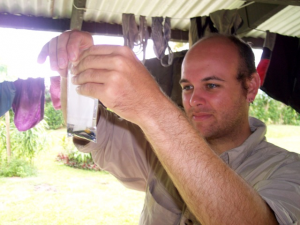Joshua Drew, a lecturer in marine conservation biology at Columbia University, offers a personal perspective on Open Access publishing from a researcher’s point of view. Having now moved to a policy of publishing entirely in Open Access journals, he talks to BioMed Central about the benefits that this can bring to researchers wishing to get the most from their publications, together with some of the challenges that lie ahead
 Open Access publishing is poised to revolutionize how science is conducted. Movement towards this publishing model will have downstream ramifications for how science is funded, collaborations established and how science is communicated. Ultimately Open Access publishing will force researchers to revaluate how we prioritize our limited resources. I believe that should researchers make a concerted effort to publish in Open Access formats we can maximize the returns on these resources.
Open Access publishing is poised to revolutionize how science is conducted. Movement towards this publishing model will have downstream ramifications for how science is funded, collaborations established and how science is communicated. Ultimately Open Access publishing will force researchers to revaluate how we prioritize our limited resources. I believe that should researchers make a concerted effort to publish in Open Access formats we can maximize the returns on these resources.
Decreasing funding rates from federal and non-governmental agencies have forced researchers to closely evaluate how finite funds are allocated. With a shift to a user pays model, authors are now forced to allocate not insubstantial funds to publishing charges. While this is nothing new – page charges have been around for decades – the ubiquity of Open Access fees means that researchers must budget in several thousand dollars for publication.* One way this pressure may be alleviated is by altering the funding structure of grant proposals. By researchers explicitly requesting funds for publication in Open Access formats they can make the case that their outcomes will reach a broader audience and have a greater influence. Of course simply asking for more money may not be the most reliable strategy and more autochthonous methods of reallocation may be in order. This may result in scientists publishing fewer but more elaborate papers, publishing with more partners (thus spreading the publishing cost over a greater field of authors) or choosing to publish with journals that have fixed yearly costs.
By choosing to publish in an Open Access journal scientists are able to expand both their impact and their potential collaborative network. Making ones research more widely available means that more eyes, in more countries, are reading that work. This establishes the potential for unique and more wide-ranging collaborations, especially with labs in developing countries. In addition, by lowering barriers to engagement with government agencies, researchers are also more likely to translate their work into policy action. I have written elsewhere about how publishing in an Open Access format can help further conservation biology. From my perspective as a researcher and conservation biologist I would only add that the major strength of publishing in an Open Access format is that it allows for the democratization of science, putting the information in the hands of managers so that they have the most current data to make informed conservation decisions.
To me there is something fundamentally inequitable about a manager in Papua New Guinea, for example, not being able to access a paper written about reefs she can see from her office, because that paper is published in a journal that her institution cannot afford.
The crux of these arguments for publishing Open Access lies in the assumption that science published in Open Access journals will be more widely read than those in closed access journals, and that increase in communication will have follow-on impacts for researcher’s success in grants and tenure. While there is mounting evidence that articles published in Open Access journals are more widely read** the downstream implications of publishing preferentially, or exclusively in Open Access journals on promotion and funding remains to be seen.
Open Access publishing offers great potential to revolutionize how we do and how we report science. However it is important for researchers interested in sailing these waters to take a critical approach at the real risks and benefits of moving over to an alternative publishing schema. I have personally moved to a completely Open Access publishing policy and have been thrilled at the response I have gotten from my colleagues. When you couple the availability of Open Access papers with the dynamic nature of social media (twitter, facebook etc.) you can reach entirely new and engaged audiences for your work, ones which you may be entirely excluding by only publishing in a closed access model. I encourage you to give it a try.
*There has yet to be coalescence around a single Open Access model, nor does their particularly need to be. Different journals are partitioning the Open Access space according to price, inclusivity and discount structure.
**Gargouri Y, Hajjem C, Larivière V, Gingras Y, Carr L, et al. (2010) Self-Selected or Mandated, Open Access Increases Citation Impact for Higher Quality Research. PLoS ONE 5(10): e13636. doi:10.1371/journal.pone.0013636
Joshua Drew is a lecturer and director of the MA program in Conservation Biology at Columbia University. His research focuses on the evolution, historical ecology and conservation of Pacific coral reef systems. He recently published the article “Biodiversity Inventories and Conservation of the Marine Fishes of Bootless Bay, Papua New Guinea” and was invited to contribute this guest blog by BMC Ecology. You can follow research in his lab on twitter at @Drew_Lab
3 Comments